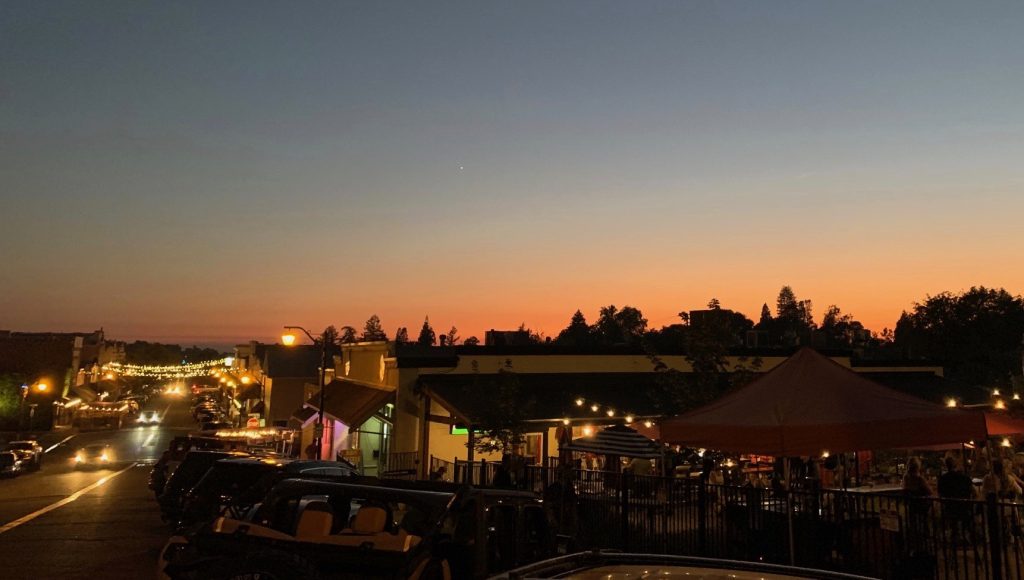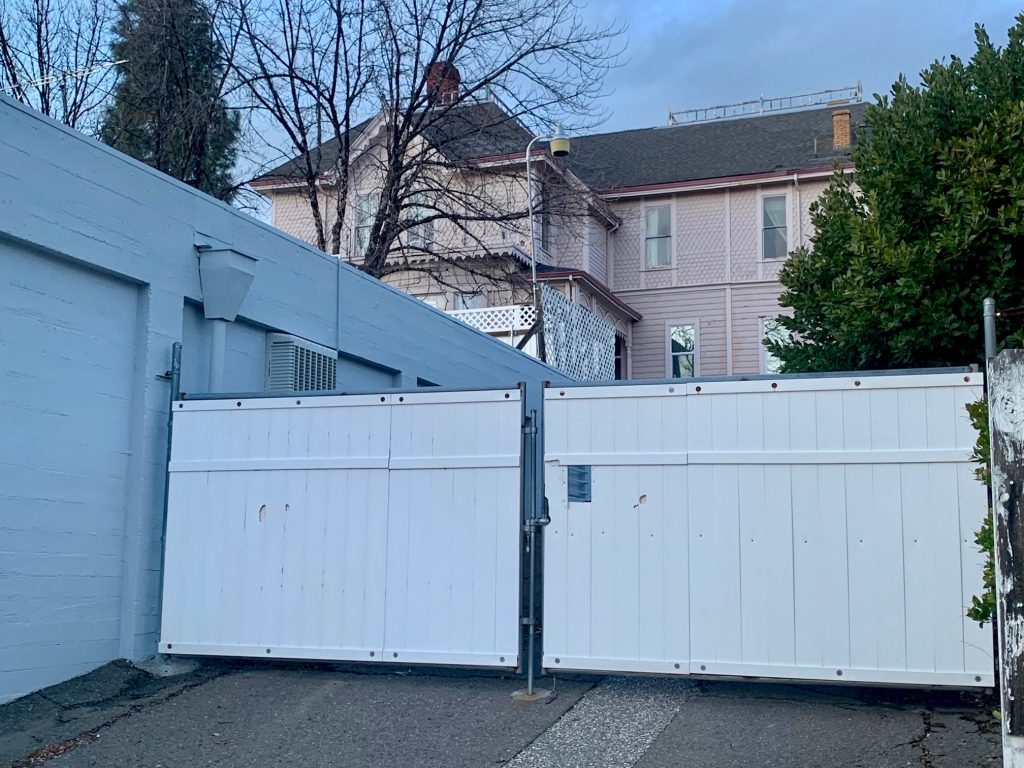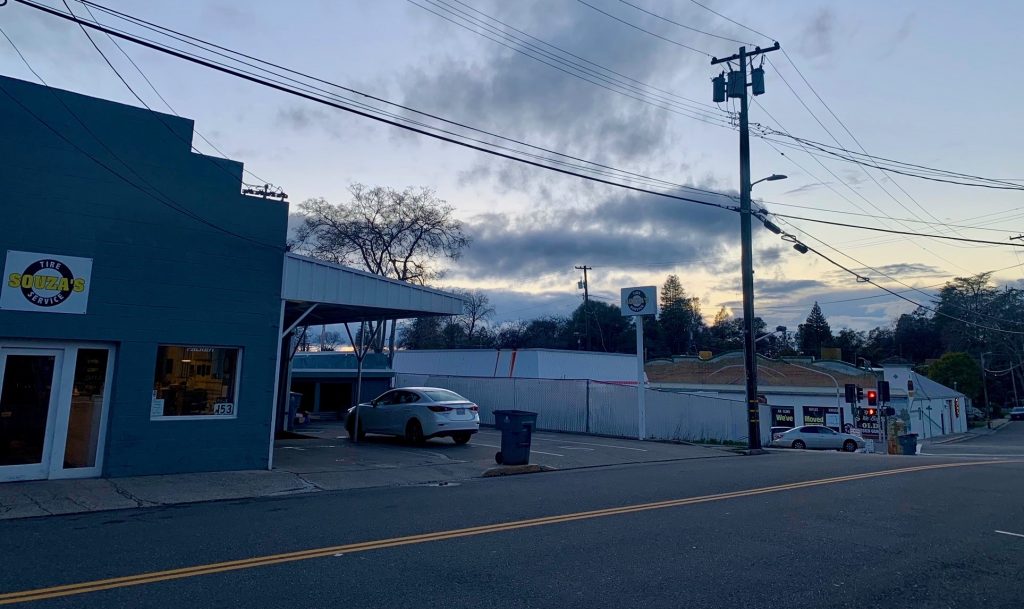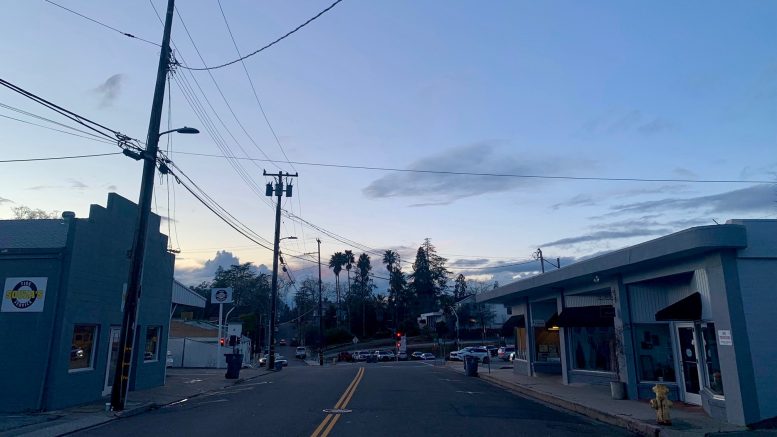It was just past 1:35 a.m. when Auburn police sergeant Anthony Davis and his partner Stan Hamelin pulled up to a blue-collar bar on the edge of the historic district. The two jumped out, moving their flashlights through a scene of near-pandemonium. They saw a woman helping a man who was groaning on the ground: he was holding his leg, which had two shattered bones popping right out of his skin. Then, Hamelin started rushing through the darkness to another body on pavement. The man’s face was battered and bloodied. His long body was splayed out motionless on the concrete. Hamelin dropped down by another woman who was huddled over him, urging his motionless face, “Please breathe, breathe, breathe – remember you were breathing for me? Please breathe.”
Davis’s flashlight and body camera were turning through the scene: both victims were down next to Souza’s tires shop, directly across from Bob and Betty’s One Sixty Club. The sergeant could see blood and broken glass not far from the bar door. There was also blood spilled in the roadway and along the sidewalk. A handful of dazed patrons were floating around the street – some with tears in their eyes – and these witnesses were already venting about two out-of-towners who’d sped away from the carnage in a black Mercedes.
It was October 16, 2019. The One Sixty Club itself was not long for this world.
“There was a sense of panic – shock,” Davis recalled at the start of a murder trial on Feb. 27. “Obviously, there was a lot of intoxication.”
Davis was testifying on the third floor of Auburn’s Gilded Age courthouse which rises above the city’s oldest quarter. He was the first of 17 witnesses to take the stand during three weeks of court action. It was a day that locals had been waiting for, a moment when attorneys would try to unravel a Gordian knot of accounts woven together by sheer confusion.
In the end, it would be up to a jury to decide exactly what happened that night.
In the prosecution’s view, it was a crime story about two interlopers wandering into a world they didn’t understand, provoking trouble with its inhabitants and then lashing out in a craven, homicidal tantrum before fleeing like cowards. One of those strangers, 29-year-old Skylar Warren-Perry, was now on trial for murder.
“The defendant was humiliated,” prosecutor Jamie Smith said in her opening argument. “He was angry, and he wanted revenge.”
But defense attorney Emily Koehler painted a very different picture of that evening. She agreed that the case hinged on two outsiders coming to Auburn and meeting problems they couldn’t handle, yet in her version, it was the defendant and his best friend who were the targets of a crazed assault followed by drunken mob mayhem. Koehler stressed that this bewildering blur led to a tragically final outcome. Specifically, Koehler argued that Warren-Perry was forced into an adrenalin-spurred fight-or-flight escape, which led to unintentionally taking a life.
“Skylar keeps repeatedly telling him, ‘I’m not here to fight – I don’t want to fight,’ Koehler said in her opening. “Skylar doesn’t say anything aggressive; but instead, Skylar pleads, four times, ‘Let me take my boy home! Just let me get my boy!”
Koehler added of her client, “The bartender described him as frightened – a deer in the headlights – ‘a pussy to the end.’”
The locals’ place

Jamie Brown had been managing the One Sixty Club for more than four years when the moment of shock arrived. Twenty-eight months and one pandemic later, Brown was summoned up the worn steps of the courthouse to testify about a now-vanished bar that he had clearly loved.
“It was an extension of everybody’s living room,” Brown told the jury. “It’s where all the locals hung out. It was the safest bar in Auburn.”
Former Auburn resident Mathew Alger had a similar take on the One Sixty. Alger was a key witness in the case against the defendant. On March 15, 2019, Alger had spent the afternoon with his friend Timothy “Ryan” Bonari. They’d been close for seven years and that day they were playing disc golf and drinking at Beach Hut Deli before heading to the One Sixty to shoot pool.
“It’s a little dive bar,” Alger said of the establishment. “Just a locals’ spot where everybody knows everybody … We’re all just having a good time in there. I mean, it’s Auburn. That’s just how it goes.”
Not that night.
Brown was tending bar when Alger and Bonari walked in. Later, during the trial, Brown was shown some surveillance footage to establish the timeline. He stared for an instant at the pub table and pool cues and then nodded heavily. “That was it,” he reflected. “That was our living room.”
Another person in the bar was Marlon Parrish. He was called to testify, sharing his own memories of the One Sixty Club.
“It was one of the nicest bars in Auburn because it was really a hometown bar,” Parrish noted. “You’d see everyone you know, and if you didn’t know someone, you would get introduced.”
But that evening, Parrish, Alger, Brown and Bonari all spotted two men they didn’t know. Alger had actually briefly met one of the strangers on a few occasions in Sacramento – catching only his first name, Skylar – but it was an encounter vague enough for him to describe the pair in court as “two out-of-town guys.”
Who were they? Warren-Perry was a Florida man, married with a baby. He’d been making efforts to move to Sacramento after his brother died.
“I was kind of looking for a fresh start,” Warren-Perry would say when it was his turn to take the stand.
The man Warren-Perry brought with him to the One Sixty Club was his late brother’s friend, Brian Banks, who lives 20 miles north of Auburn in Forresthill. The two were there to have some drinks, blow off steam and reminisce about a shared loss in their lives. They drove in to Auburn in Warren-Perry’s 2016 C250 Mercedes.
The first spot the two started drinking at was nearby bar called Pistol Pete’s. They had cocktails and sang karaoke there before heading down to the One Sixty around 12:49 p.m. When they strolled in, they noticed Bonari hanging out with a woman named Heather Mitchell. At some point, Mitchell drifted down the bar to where Warren-Perry was. He bought her a drink. When she headed back over to Bonari, who was next to Marlon Parrish, everyone heard Brian Banks blurt out the word, “Putah.”
“He came down to the end of the bar and said, ‘Putah!’” Parrish told the jury. “He was saying it to Ryan and I … That’s a very bad word in Spanish. I said, ‘Who are you calling a Putah?’”
Parrish, who’s Black, added, “When I confronted him, [Banks] said, ‘You don’t look like you’re from around here.’ I said, ‘Well I live here, even if I’m not from here.’ He said, ‘Well, we weren’t talking to you.’”
“He was calling Ryan a Putah,” Parrish continued. “It was very clear why Ryan was being called a Putah – because he was playing pool with the girl that the guy with the neck tattoos was buying drinks for.”
According to Alger’s account, he hadn’t taken notice of this early dust-up. Yet, when prosecutor Laurie Smith showed Alger video footage of Bonari taken shortly before it happened – in an effort to peg where people were standing – the witness took a long, unexpected pause as he watched. “I’m sorry,” he said quietly to the judge. “It’s the first time I’ve seen Ryan in a while.”
“That’s Ryan?” Smith asked.
“Yeah,” Alger said, more to himself, “you can see Ryan’s big, cheesy smile.”
An argument flared up. Someone stepped out of the bar to where several men were smoking. One of them was Trinidad Elizarraras, an on-and-off again bouncer for the One Sixty. Though Elizarraras wasn’t working that night, he was told about the trouble.
“They were trying to look badass, as they say,” Elizarraras remembered of strangers. “I went inside, looked at Jamie the bartender to see if he wanted them gone, or if everything was okay. I was there to de-escelate – to get them apart from each other … It didn’t go too bad.”
Warren-Perry testified that he too was trying to calm the situation.
“When I saw things get heated, I just pushed Brian back and said, ‘Brother, just calm down – chill,’” the defendant said. “They hugged. Everything was fine. They bought each other drinks.”
Later, Warren-Perry added, “Brian was being a little obnoxious, so I apologized to Marlon.”
Behind the bar, Jamie Brown assumed the problems were over.
“It was just a little chest-puffing,” he noted with a shrug. “Just typical bar shit.”
But there was nothing typical about what happened next.
The vest and the violence

Parrish headed home, but others went outside to smoke. More regulars also arrived, including Nick Vansambeek, another occasional bouncer for the club. Camera footage shows Elizarraras talking to the group, wearing a distinctive vest-and-hoodie ensemble that he was often seen sporting around Auburn. An audio feed from a nearby traffic camera was enhanced for the jury, allowing its members to hear fragments from this five-way conversation.
In that recording, Banks can be heard asking Elizarraras about his vest.
“Are you a rider, bro?” the mic picked up. The response is not heard, only Banks’ follow-up question: “What are you?”
Then, an unidentified man can be heard answering on behalf of Elizarraras, “He’s a Latin King.”
When Warren-Perry was listening to this audio on the witness stand, he told the jury that – being from Florida – he knew the term Latin King.
“What’s Latin Kings?” his attorney, Emily Koehler, asked.
“It’s a gang,” Warren-Perry said. “Trinidad was talking about it.”
“Was that before things got hostile?”
Warren-Perry nodded: “Yeah, I said I was from Florida and he said, ‘Yeah, there’s a lot of Latin Kings out there. I’m a Latin King.’”
“Did that worry you?” Koehler went on.
“Not then, but I took note of it,” Warren-Perry replied.
After Banks started asking Elizarraras about his vest, the two stepped over to a nearby alcove. It was a blind spot – the bar’s camera couldn’t see into it, nor could the group of smokers.
What happened inside the alcove was a point of contention in the trial. What’s known for sure is that – 40 seconds later – the smokers heard someone drop a cocktail glass, which shattered on the pavement. Then they suddenly noticed Banks bowled-over on the sidewalk with blood spouting from his face. Auburn police later documented that Banks had a blackened eye, major bruising in his mouth, a contusion behind his left ear, cuts and scrapes to his hands and a large contusion to the back of his skull.
Elizarraras testified that Banks had tried to yank off his signature vest, so he simply pushed Banks away, which caused the other man to fall.
“You just shoved him to the ground?” Koehler pressed during cross-examination.
“Oh yeah,” Elizarraras said, “but he fell really hard.”
However, Warren-Perry told the jury that he’d started approaching the alcove and saw what happened.
“As Brian was lightening up a cigarette, Trinidad cocked back and sucker punched him, and Brian went down like a sack of potatoes,” the defendant said. “I was scared; and then Trinidad started chasing me. He had this look in his eyes … It’s like his eyes went black.”
Did Elizarraras attack Banks? Koehler grilled retired Auburn police detective Angela McCollough on this point, asking how she could accept Elizarraras’ story given the extend of Banks’ injuries.
“In your time in law enforcement, you’ve been called to many fights, correct?” she began. “Are all those injuries Mr. Banks had consistent with someone simply being pushed down?”
“It’s – it’s hard to say,” McCollough answered. “It would depend on circumstances.”
Elizarraras admitted on the stand that he’d been drinking Jamison and beer and doing cocaine that night.
“I was pretty intoxicated inside the bar, before the adrenalin kicked in when everything was happening,” he explained. “Remembering everything is like bits and pieces.”
“When you went into the alcove, what was [Banks] asking about the patches on your vest?” Koehler inquired.
“I don’t recall,” Elizarraras muttered.
“One of the things he told you about your vest was, ‘It’s gay,’ right?”
“Yes,” he grumbled.
“Do you recall telling detectives that all the patrons of the bar got mad at you because they were saying you ‘went crazy?’” Koehler continued.
“I don’t remember that.”
“Do you remember telling detectives, about Mr. Banks, ‘that dude was knocked the fuck out?’”
“No.”
“Do you recall Nick Vansambeek saying, ‘Stop, Jesus, fuck, what, are you trying to kill the guy?’”
Elizarraras said that he didn’t remember that, and Vansambeek himself would later testify he didn’t remember it either.
How Banks ended up on the ground was up for debate during the trial, but what Elizarraras did next, less so.
The chase

The smokers at the bar had seen Banks, in one their words, with “piles of blood coming off his face.”
Surveillance footage then shows Warren-Perry frantically wheeling back on his heels towards the group. In an instant, Elizarraras comes into the picture with his fists up. The audio feed captures him yelling, “What’s up, son?” And then, “You wanna play?”
It also records Warren-Perry reacting with, “Watch out. Watch out. I didn’t do shit to you.”
Five of the Auburn locals near the bar door were called to testify. While their memories differ slightly after three-and-a-half years, they all agreed that Elizarraras was bolting towards Warren-Perry.
“Trinidad is like a light switch,” Alger mentioned on the stand. “I don’t think any of us knew what was going on at that point.”
Steven Cantrell recalled thinking Warren-Perry was in trouble.
“Trinidad likes to fight,” he said flatly. “That night he was being aggressive.”
“Is it fair to say that you don’t personally like Trinidad?” Smith asked Cantrell at one point.
“No, I wouldn’t say that,” Cantrell told her. “But he did knock my friend’s teeth out, which is kind of a dick move.”
Regardless of Elizarraras’s state of mind, cameras show him chasing Warren-Perry in and out of the One Sixty Club. The audio feed also records Elizarraras shouting, “Why you runnin’, bitch!” and “You fa****-ass Florida pussy!” The pursuer and his target make three full circles through the bar and then back onto the street, with Warren-Perry being cut off from escaping to his car at least once.
Elizarrarasa downplayed going after the stranger when he testified. “I wasn’t really trying to beat him up, I just wanted them to get out of there,” he offered. “I was upset.”
“Do you recall telling detectives that Skylar was ‘running like an antelope or a gazelle?’” Koehler asked.
Elizarraras nodded. “Yeah, something like that.”
Warren-Perry related from the stand what went through his mind.
“He’d taken a swing at me the first time I tried to get to my car, which I was able to duck,” he said of Elizarraras. “Brian was already knocked out and bleeding. There was no one else to help me, and I just felt alone.”
Then, Elizarrras reportedly shouted something that the audio feed doesn’t capture. Yet, two people heard iterations of it. One was Alger. Trying to make sense of the disarray, he thought heard Elizarrras shout something to the effect of, “Then go get your gun!” Alger testified that he believed this was a challenge to Warren-Perry, which Alger took to mean that the stranger might have threatened having a weapon in his vehicle.
“I was worried that [Warren-Perry] would get a gun from his car and start shooting at the people in the bar,” Alger remembered.
Warren-Perry heard Elizarrras say essentially the same thing, though he believed it was, “Go get your gun!” Warren-Perry claims to have thought Elizarrras was demanding one of the patrons grab a pistol for him.
“Trinidad was raging – he was going ballistic,” Warren-Perry recounted. “I thought I wasn’t going to make it home to my daughter.”
The stress and tension in the bar was spiking. Multiple people were shouting at Warren-Perry to leave. A few of them tried grabbing and kicking him. Jamie Brown, the bartender, felt the whole energy shift. “He was running in a way that wasn’t normal,” he noted of Warren-Perry. “It had just gone from zero to a hundred it seemed like.”
After Warren-Perry dodged Elizarrras for the third time, he was running by Vansambeek, who tripped him to the ground.
“I pulled back to take a swing at him,” Vansambeek recalled in the courtroom, “but he threw his hands up and said he didn’t want to fight, that he just wanted to grab his buddy and leave. I said to him, ‘Then get your buddy and get the fuck out of here!’”
At that point, the surveillance footage shows Vansambeek stop an approaching Elizarrras in the middle of the street, waving him off.
“I told him, ‘They want to leave,’” Vansambeek said. “I was trying to calm [Elizarrras] down. I ended up walking him over towards Souza’s.”
For an instant it seemed like the drama was over.
The turn

After Vansambeek let him go, Warren-Perry finally reached his car. He got in, fired the ignition and then heard a loud banging noise echo on the dim street. The microphone caught that sound, though not clearly enough for witnesses and experts to agree on what it was. Warren-Perry told the jury that he thought it was a gunshot.
“I was scared shitless,” he admitted. “At that point, I was contemplating just leaving Brian, but I knew if I did, I couldn’t live with myself.”
No other person at the bar reported hearing a gunshot.
What can be pieced together from various accounts and the camera footage is that Vansambeek and Elizarrras began walking away from the situation, strolling off towards the parking area of Souza’s Tire Service. At that point, Warren-Perry pulled his Mercedes up along the alcove where Banks was still nodding off. Two locals, Jessie Perez and Caleb “Cowboy” Salomon, helped load Banks’ slumped frame into the passenger seat. As Warren-Perry began to pull out, Solomon can be seen waving his cowboy hat in a broad sweep, urging the strangers to just drive off.
Then the world turned with the turn of a steering wheel.
The entire murder case against Warren-Perry centers on that 14.5 seconds of video footage recorded next. In it, there’s a totally open roadway between the bar and the intersection of High Street, which could take Warren-Perry and Banks out of the city. Down the way and across the street, Vansambeek and Elizarrras are standing as they chat and smoke next to the tire shop. As the black Mercedes starts to drive straight towards the intersection, Vanzambeek flips it off and Elizarrras shouts something at it. Then, the car makes an abrupt and sudden left turn straight at the two of them. Vansambeek testified that he was able to hit the front of the car with his hand and push himself back as it swept in. His leg was hit, though he wasn’t badly hurt. Depending on whose account one believes, Elizarrras was either hit and thrust up onto the hood of the Mercedes, or, he was not hit, but jumped onto the hood of the Mercedes. Either way, Elizarrras started striking the car’s windshield, over and over, splintering large holes in it. Vansambeek started punching at the passenger side of the car.
“I was trying to break through and get to him,” Vansambeek said on the stand, motioning to where Warren-Perry sat in the courtroom.
The camera shows that, as this turbulent scene unfolded, Alger and Bonari rushed across the street towards the back of the Mercedes. Alger’s testimony suggests that he and Bonari thought Warren-Perry just tried to kill two people they knew and were trying to stop him. Unfortunately, within seconds of the pair hurrying over, Warren-Perry threw the Mercedes into reverse and spun backwards at a sharp angle. Elizarrras was sucked underneath one of the front wheel wells, shattering the bones in his leg. Bonari was hit by the back of the car and hurtled into the air over its trunk, crashing down on the cement. In the same continued motion, the Mercedes drove over the top of his chest.
“He just went head over heels and landed on his back,” said Lee Whiting, a witness who knew Bonari. “Ryan just came from nowhere – I don’t know where; but when the car backed up, it knocked him head over heels.”
Jamie Brown saw the same thing.
“Matt went running over there,” Brown stopped and choked up with tears, “and then Ryan did … I watched Ryan go down. There was this awful noise. I’ll never forget that.”
When Alger was watching the video in court, he was overcome by emotion and broke down. Even Vansambeek, who had been generally stoic before the jury, got cloudy-eyed when he saw the footage.
Placer County pathologist Greg Reiber, who’d performed Bonari’s autopsy, testified that the victim’s brain stem was torn, which would have rendered him instantly unconscious and paralyzed. Bonari sustained additional complex skull fractures and direct brain trauma. He was pronounced dead in the hours that followed. Warren-Perry rarely looked up when Bonari’s autopsy photos were shown.
Attack or escape?

From the opening moments of the trial, Koehler told the jurors that if they were only looking at that 14 seconds of video, then it could appear that her client tried to run-down two people before killing a third while in reverse. Indeed, that roughly matches what Alger, Whiting, Brown, Vansambeek, Elizarrras and another local named Casey Schleth all testified to seeing.
In an effort to offer another explanation, Koehler had Warren-Perry take the witness stand. The defendant claimed that, in his sheer desperation to flee from the One Sixty Club, he had noticed that the light at the High Street intersection was red. Warren-Perry said that, earlier that evening, he’d briefly driven down an alley at the side of Souza’s Tire while looking for parking. Now, he claimed, he was trying to quickly duck down the same portal to get away, but being that it was dark and he was unfamiliar with the street, he turned in the wrong spot, believing the car port for Souza’s was the alleyway. Warren-Perry told the jury that he never saw Vansambeek or Elizarrras while he was yanking the wheel – only once the two of them were assaulting the windows and windshield of his car. He also told jurors that Elizarrras was able to damage his windshield to such devastating effect because he was holding “a small metal object,” which Warren-Perry claimed was a gun (no other witnesses reported seeing a gun at any point, but Elizarrras also had no injuries to his hands – he said that he was making hammering strikes down with the bottom of his fists rather than punching straight).
Warren-Perry recalled that Banks was starting to come to, screaming for him to get out of there. The defendant asserted that he never saw Alger or Bonari behind his car when he threw it in reverse, which is why he left the scene and didn’t look back.
Offered a chance at trying to shred Warren-Perry’s story before the jury, Smith took it.
“You thought, ‘Oh my god, my life is in danger,’ but you were still worried about running a red light?” she challenged. “You were worried about an infraction?”
“Yeah, I was panicking,” Warren-Perry replied. “I didn’t really think – there was so much going on and Brian was bleeding.”
“Did you feel Ryan’s body get dragged under your vehicle?” Smith went on.
“No,” the defendant answered in a near-whisper.
“So, after you ran the red light, at what point did you call 911?”
“I didn’t call 911.”
“You thought your friend was assaulted, that you were mob-attacked, and that someone came at you with a gun, but you didn’t call the police?”
“No,” Warren-Perry offered. “I was just thankful to get away.”
During the trial, the defense called Jason Fries to testify, a forensics expert in laser-scanning, lighting scenarios and video reconstruction. Fries gave an elaborate presentation about the crime scene, one which argued that Warren-Perry did not see Vansambeek and Elizarrras when he made the turn. The prosecution called its own expert, Chris Kauderer, a mechanical engineer who specializes in accident reconstruction. In Kauderer’s own lengthy presentation, he argued that Warren-Perry’s explanation did not hold up to the facts and circumstances of the scene.
The last witness to testify was retired California Highway Patrol Lieutenant Charles Swift, an expert in firearms and traffic accident investigation. He was called to by the defense. Swift told the jury that he’d examined Warren-Perry’s Mercedes and that its backup camera had a 1.6-second lag time before activating. He also said that, based on his analysis of the scene, Alger and Bonari were in Warren-Perry’s blind spot for nearly the entire time they were running towards his car
Perhaps the most provocative element of Swift’s testimony involved that loud bang the audio feed picked up. The former officer said he’d examined it with specialized software, and he believed it was “consistent with a gunshot.”
Next, Koehler asked the expert about the Mercedes’ broken windshield.
“Have you ever seen a windshield broken by a fist when the person didn’t sustain an injury?” she probed.
“I never have,” Swift responded, adding that he’d been to more than a thousand vehicle incidents.
“In your training and experience, what do you think broke the windshield?”
“A relatively small object.”
“Would the butt of a gun be consistent with those cracks in the glass?”
“Yes,” Swift replied.
Smith countered by asking a line of questions to undermine whether the retired officer was really qualified to make those assessments. She also pointed out that no one else at the One Sixty Club acted as if they’d seen or heard a gun. The jury would have to decide.
On March 14, Placer County Judge Garen J. Horst prepared the jury to hearing closing arguments. Warren-Perry was facing a charge of Second-degree murder over Bonari’s death and two counts of pre-mediated attempted murder related to Elizarrras and Vansambeek. He was also charged with failing to stop at an accident.
The prosecution started out by encouraging the jurors to trust what they’d seen in the videos and still frames and how that related to the totality of witness statements.
“You saw the defendant accelerate and make that sharp turn,” Smith told them. “You watch Ryan get hit by the vehicle – you saw his body concave and fly over … [Warren-Perry] takes off very quick, runs that red light and then he’s gone.”
Smith also tried to contextualize the attacks on Banks and Warren-Perry.
“Trinidad was angry and aggressive, and he was being an asshole that night – I asked him about that, and he agreed that he was, because there’s video and audio of it,” Smith acknowledged. “We heard the screams of the individuals who were left behind when the defendant fled.”
Before ending, Smith returned to Warren-Perry’s claims that someone had fired a gun.
“We all know human nature,” Smith said. “We know how people would have acted if there was a gunshot.”
When Koehler rose before the jury, she asked the jurors to put themselves in Warren-Perry place night. It was, the attorney hammered home, about an accident that happened while someone reached their breaking-point.
“When we talk about fight or flight, all the evidence tells us that Skyler is a flighter – every chance he got, he ran,” Koehler emphasized. “He could have turned at any time and fought Trinidad in the street. He never chose to do that, and it’s important because it goes to Skylar’s mental state … We have to look at the totality of everything going on.”
Koehler continued, “Trinidad described Skylar as running like an antelope or gazelle, and I think that was an interesting choice of words – Skylar was running like prey who was being hunted.”
Then, turning to the video screen, she added, “The prosecutor said, ‘this is what intent looks like.’ That’s not true. This is what fear looks like.”
On March 16, the jury found Warren-Perry not guilty on all charges.
Scott Thomas Anderson is also the writer-producer of the true crime podcast series ‘Trace of the Devastation.’


I was wondering how that case came out. (I was a potential juror). Sad situation all around. He ended up doing 4 years anyhow while waiting for his case to be heard.